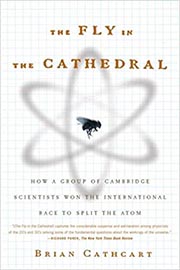The Fly in the Cathedral: How a Group of Cambridge Scientists Won the International Race to Split the Atom
by Brian Cathcart
Reviewed July 18, 2007
 So often, the story of the race to unlock the secrets of the atom focuses on the work of Lise Meitner, Otto Hahn and Fritz Strassmann. To properly tell the history, however, one needs to look to Cambridge's Cavendish Laboratory and the year 1932.
So often, the story of the race to unlock the secrets of the atom focuses on the work of Lise Meitner, Otto Hahn and Fritz Strassmann. To properly tell the history, however, one needs to look to Cambridge's Cavendish Laboratory and the year 1932.
Brian Cathcart's The Fly in the Cathedral: How a Group of Cambridge Scientists Won the International Race to Split the Atom, retells the genesis of nuclear physics in this first rate book. He takes the reader back to the early research laboratories, where scientists toiled with homemade apparatus, sealing wax, and luck. It is hard to imagine what research was like before the era of "Big Science". In this 320 page book, Cathcart frames the discovery of atomic fission perfectly in this environment.
Before the world erupted into the second world war, labs across the globe raced to understand the atomic nucleus. Under the leadership of Sir Ernest Rutherford, two young scientists raced toward this goal. John Cockcroft and Ernest Walton lead the effort at Cavendish. Building upon the quantum mechanical theories put forth by the flamboyant Russian, George Gamow, they thought it was possible to drive either an alpha particle or a single proton into a larger nucleus, causing it to split, or fission.
Cathcart provides a wonderful insight to these future giants of the physics world. He draws the title of the book from a statement by Rutherford comparing the size of the nucleus to a fly on the ceiling of a cathedral.
The book reveals in rich detail the incredible story of this scientific breakthrough that won the pair a Nobel Prize in Physics in 1951. Although the end result of this discovery did lead to the creation of the atomic bomb, this by no means should dampen this achievement.
Anyone who enjoyed the first portion of Richard Rhodes' The Making of the Atomic Bomb will greatly enjoy The Fly in the Cathedral.
Available at amazon.com.